Holger Boche
Variational Secret Common Randomness Extraction
Oct 02, 2025Abstract:This paper studies the problem of extracting common randomness (CR) or secret keys from correlated random sources observed by two legitimate parties, Alice and Bob, through public discussion in the presence of an eavesdropper, Eve. We propose a practical two-stage CR extraction framework. In the first stage, the variational probabilistic quantization (VPQ) step is introduced, where Alice and Bob employ probabilistic neural network (NN) encoders to map their observations into discrete, nearly uniform random variables (RVs) with high agreement probability while minimizing information leakage to Eve. This is realized through a variational learning objective combined with adversarial training. In the second stage, a secure sketch using code-offset construction reconciles the encoder outputs into identical secret keys, whose secrecy is guaranteed by the VPQ objective. As a representative application, we study physical layer key (PLK) generation. Beyond the traditional methods, which rely on the channel reciprocity principle and require two-way channel probing, thus suffering from large protocol overhead and being unsuitable in high mobility scenarios, we propose a sensing-based PLK generation method for integrated sensing and communications (ISAC) systems, where paired range-angle (RA) maps measured at Alice and Bob serve as correlated sources. The idea is verified through both end-to-end simulations and real-world software-defined radio (SDR) measurements, including scenarios where Eve has partial knowledge about Bob's position. The results demonstrate the feasibility and convincing performance of both the proposed CR extraction framework and sensing-based PLK generation method.
Fixing It in Post: A Comparative Study of LLM Post-Training Data Quality and Model Performance
Jun 06, 2025Abstract:Recent work on large language models (LLMs) has increasingly focused on post-training and alignment with datasets curated to enhance instruction following, world knowledge, and specialized skills. However, most post-training datasets used in leading open- and closed-source LLMs remain inaccessible to the public, with limited information about their construction process. This lack of transparency has motivated the recent development of open-source post-training corpora. While training on these open alternatives can yield performance comparable to that of leading models, systematic comparisons remain challenging due to the significant computational cost of conducting them rigorously at scale, and are therefore largely absent. As a result, it remains unclear how specific samples, task types, or curation strategies influence downstream performance when assessing data quality. In this work, we conduct the first comprehensive side-by-side analysis of two prominent open post-training datasets: Tulu-3-SFT-Mix and SmolTalk. Using the Magpie framework, we annotate each sample with detailed quality metrics, including turn structure (single-turn vs. multi-turn), task category, input quality, and response quality, and we derive statistics that reveal structural and qualitative similarities and differences between the two datasets. Based on these insights, we design a principled curation recipe that produces a new data mixture, TuluTalk, which contains 14% fewer samples than either source dataset while matching or exceeding their performance on key benchmarks. Our findings offer actionable insights for constructing more effective post-training datasets that improve model performance within practical resource limits. To support future research, we publicly release both the annotated source datasets and our curated TuluTalk mixture.
"Don't Do That!": Guiding Embodied Systems through Large Language Model-based Constraint Generation
Jun 04, 2025Abstract:Recent advancements in large language models (LLMs) have spurred interest in robotic navigation that incorporates complex spatial, mathematical, and conditional constraints from natural language into the planning problem. Such constraints can be informal yet highly complex, making it challenging to translate into a formal description that can be passed on to a planning algorithm. In this paper, we propose STPR, a constraint generation framework that uses LLMs to translate constraints (expressed as instructions on ``what not to do'') into executable Python functions. STPR leverages the LLM's strong coding capabilities to shift the problem description from language into structured and transparent code, thus circumventing complex reasoning and avoiding potential hallucinations. We show that these LLM-generated functions accurately describe even complex mathematical constraints, and apply them to point cloud representations with traditional search algorithms. Experiments in a simulated Gazebo environment show that STPR ensures full compliance across several constraints and scenarios, while having short runtimes. We also verify that STPR can be used with smaller, code-specific LLMs, making it applicable to a wide range of compact models at low inference cost.
Computation of Capacity-Distortion-Cost Functions for Continuous Memoryless Channels
Apr 28, 2025


Abstract:This paper aims at computing the capacity-distortion-cost (CDC) function for continuous memoryless channels, which is defined as the supremum of the mutual information between channel input and output, constrained by an input cost and an expected distortion of estimating channel state. Solving the optimization problem is challenging because the input distribution does not lie in a finite-dimensional Euclidean space and the optimal estimation function has no closed form in general. We propose to adopt the Wasserstein proximal point method and parametric models such as neural networks (NNs) to update the input distribution and estimation function alternately. To implement it in practice, the importance sampling (IS) technique is used to calculate integrals numerically, and the Wasserstein gradient descent is approximated by pushing forward particles. The algorithm is then applied to an integrated sensing and communications (ISAC) system, validating theoretical results at minimum and maximum distortion as well as the random-deterministic trade-off.
SafeMERGE: Preserving Safety Alignment in Fine-Tuned Large Language Models via Selective Layer-Wise Model Merging
Mar 21, 2025
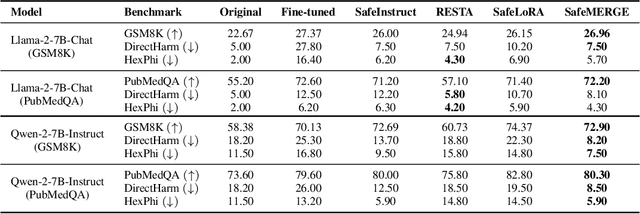
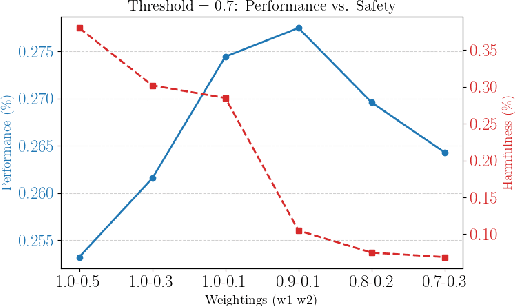
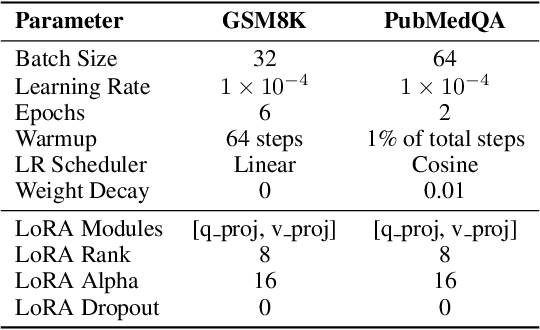
Abstract:Fine-tuning large language models (LLMs) on downstream tasks can inadvertently erode their safety alignment, even for benign fine-tuning datasets. We address this challenge by proposing SafeMERGE, a post-fine-tuning framework that preserves safety while maintaining task utility. It achieves this by selectively merging fine-tuned and safety-aligned model layers only when those deviate from safe behavior, measured by a cosine similarity criterion. We evaluate SafeMERGE against other fine-tuning- and post-fine-tuning-stage approaches for Llama-2-7B-Chat and Qwen-2-7B-Instruct models on GSM8K and PubMedQA tasks while exploring different merging strategies. We find that SafeMERGE consistently reduces harmful outputs compared to other baselines without significantly sacrificing performance, sometimes even enhancing it. The results suggest that our selective, subspace-guided, and per-layer merging method provides an effective safeguard against the inadvertent loss of safety in fine-tuned LLMs while outperforming simpler post-fine-tuning-stage defenses.
Sustainable AI: Mathematical Foundations of Spiking Neural Networks
Mar 03, 2025Abstract:Deep learning's success comes with growing energy demands, raising concerns about the long-term sustainability of the field. Spiking neural networks, inspired by biological neurons, offer a promising alternative with potential computational and energy-efficiency gains. This article examines the computational properties of spiking networks through the lens of learning theory, focusing on expressivity, training, and generalization, as well as energy-efficient implementations while comparing them to artificial neural networks. By categorizing spiking models based on time representation and information encoding, we highlight their strengths, challenges, and potential as an alternative computational paradigm.
$SE(3)$-Based Trajectory Optimization and Target Tracking in UAV-Enabled ISAC Systems
Jan 20, 2025


Abstract:This paper introduces a novel approach to enhance the performance of UAV-enabled integrated sensing and communication (ISAC) systems. By integrating uniform planar arrays (UPAs) and modeling the UAV as a rigid body using $SE(3)$, the study addresses key challenges in existing ISAC frameworks, such as rigid-body dynamics and trajectory design. We propose a target tracking scheme based on extended Kalman filtering (EKF) in $SE(3)$ and trajectory optimization from a control signal design perspective, leveraging the conditional Posterior Cramer-Rao bound (CPCRB) to optimize performance. Numerical results demonstrate the effectiveness of the proposed method in improving target tracking and trajectory optimization for a UAV-enabled MIMO-OFDM ISAC system.
Computing Capacity-Cost Functions for Continuous Channels in Wasserstein Space
Jan 18, 2025

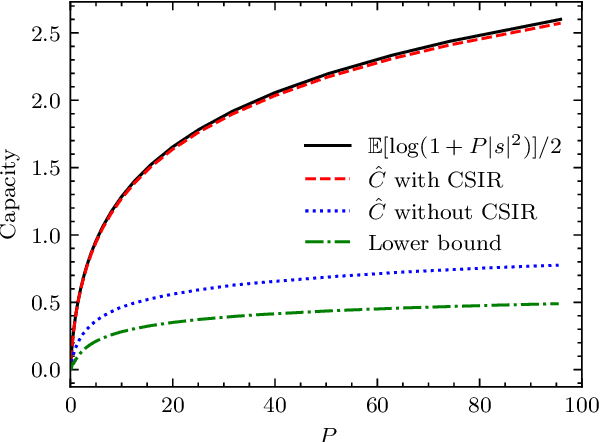
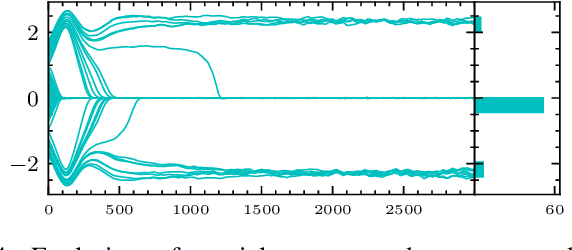
Abstract:This paper investigates the problem of computing capacity-cost (C-C) functions for continuous channels. Motivated by the Kullback-Leibler divergence (KLD) proximal reformulation of the classical Blahut-Arimoto (BA) algorithm, the Wasserstein distance is introduced to the proximal term for the continuous case, resulting in an iterative algorithm related to the Wasserstein gradient descent. Practical implementation involves moving particles along the negative gradient direction of the objective function's first variation in the Wasserstein space and approximating integrals by the importance sampling (IS) technique. Such formulation is also applied to the rate-distortion (R-D) function for continuous source spaces and thus provides a unified computation framework for both problems.
Deep-Unrolling Multidimensional Harmonic Retrieval Algorithms on Neuromorphic Hardware
Dec 05, 2024



Abstract:This paper explores the potential of conversion-based neuromorphic algorithms for highly accurate and energy-efficient single-snapshot multidimensional harmonic retrieval (MHR). By casting the MHR problem as a sparse recovery problem, we devise the currently proposed, deep-unrolling-based Structured Learned Iterative Shrinkage and Thresholding (S-LISTA) algorithm to solve it efficiently using complex-valued convolutional neural networks with complex-valued activations, which are trained using a supervised regression objective. Afterward, a novel method for converting the complex-valued convolutional layers and activations into spiking neural networks (SNNs) is developed. At the heart of this method lies the recently proposed Few Spikes (FS) conversion, which is extended by modifying the neuron model's parameters and internal dynamics to account for the inherent coupling between real and imaginary parts in complex-valued computations. Finally, the converted SNNs are mapped onto the SpiNNaker2 neuromorphic board, and a comparison in terms of estimation accuracy and power efficiency between the original CNNs deployed on an NVIDIA Jetson Xavier and the SNNs is being conducted. The measurement results show that the converted SNNs achieve almost five-fold power efficiency at moderate performance loss compared to the original CNNs.
R-MTLLMF: Resilient Multi-Task Large Language Model Fusion at the Wireless Edge
Nov 27, 2024



Abstract:Multi-task large language models (MTLLMs) are important for many applications at the wireless edge, where users demand specialized models to handle multiple tasks efficiently. However, training MTLLMs is complex and exhaustive, particularly when tasks are subject to change. Recently, the concept of model fusion via task vectors has emerged as an efficient approach for combining fine-tuning parameters to produce an MTLLM. In this paper, the problem of enabling edge users to collaboratively craft such MTTLMs via tasks vectors is studied, under the assumption of worst-case adversarial attacks. To this end, first the influence of adversarial noise to multi-task model fusion is investigated and a relationship between the so-called weight disentanglement error and the mean squared error (MSE) is derived. Using hypothesis testing, it is directly shown that the MSE increases interference between task vectors, thereby rendering model fusion ineffective. Then, a novel resilient MTLLM fusion (R-MTLLMF) is proposed, which leverages insights about the LLM architecture and fine-tuning process to safeguard task vector aggregation under adversarial noise by realigning the MTLLM. The proposed R-MTLLMF is then compared for both worst-case and ideal transmission scenarios to study the impact of the wireless channel. Extensive model fusion experiments with vision LLMs demonstrate R-MTLLMF's effectiveness, achieving close-to-baseline performance across eight different tasks in ideal noise scenarios and significantly outperforming unprotected model fusion in worst-case scenarios. The results further advocate for additional physical layer protection for a holistic approach to resilience, from both a wireless and LLM perspective.
 Add to Chrome
Add to Chrome Add to Firefox
Add to Firefox Add to Edge
Add to Edge